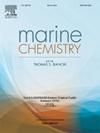Tracing marine and terrestrial biochemical signatures of particulate organic matter in an Arctic fjord (Kongsfjorden)
IF 3
3区 地球科学
Q2 CHEMISTRY, MULTIDISCIPLINARY
引用次数: 0
Abstract
Arctic fjords are hotspot for organic matter (OM) transformation and storage, however, the composition and sources of the particulate organic matter (POM) are still not completely understood. Further, due to the ongoing enhancement in the glacier melting, runoff, and precipitation, the coastal Arctic is expecting considerable increase in POM inputs. Therefore, we investigated the biochemical composition of the POM through the application of stable isotopes, C:N ratio, and biomolecules, across different regions and depths in Kongsfjorden (Svalbard) during the late-summer. We observed that Kongsfjorden-POM was characterized by low δ13C (−29.0 to −26.7 ‰) with similar values at different locations (inner to outer) of the fjord at each depth. However, C:N ratio showed increasing trend (5.7 to 10.9) from outer to inner fjord indicating marine to terrestrial transition. Monosaccharide distribution (such as fucose, galactose, arabinose, xylose, ribose, and rhamnose) and their diagnostic ratios supported the marine versus terrestrial gradient in the POM characteristics in the surface water across the fjord. Only the outermost station showed consistent biochemical distribution indicative of phytoplanktonic sources in the POM, while the rest of the fjord showed mixed signatures of marine and terrestrial sources. Higher abundance of mannuronic acid (26.6–50.8 mol%) at the middle and bottom depths highlighted possible macroalgal contribution to the POM. The stratified surface water had a relatively higher (0.5–2 ‰) δ13C and carbohydrates (40–65 μg/L) than the middle and bottom depths, with a strong positive correlation between δ13C and particulate carbohydrates, indicating a stratification-induced distribution of POM. The study showed the importance of non-phytoplanktonic OM sources, such as terrestrial, freshwater and macroalgae POM in the fjord water column, and the fate of labile (carbohydrates) fraction that predominates in stratified surface waters. Therefore, the future warm and wet Arctic will most likely lead to changes in the fate of the organic matter in the fjord water.
追踪北极峡湾(孔斯峡湾)颗粒有机物的海洋和陆地生物化学特征
北极峡湾是有机物(OM)转化和储存的热点地区,但人们对颗粒有机物(POM)的组成和来源还不完全了解。此外,由于冰川融化、径流和降水量的不断增加,北极沿岸的 POM 输入量预计将大幅增加。因此,我们在康斯峡湾(斯瓦尔巴群岛)的夏末,通过应用稳定同位素、碳氮比和生物大分子,研究了不同区域和不同深度的 POM 的生物化学组成。我们观察到,康斯峡湾-POM 的特点是 δ13C 值低(-29.0 至 -26.7‰),峡湾不同位置(从内到外)每个深度的δ13C 值相似。然而,从峡湾外侧到内侧,C:N 比值呈上升趋势(5.7 至 10.9),表明海洋向陆地过渡。单糖分布(如岩藻糖、半乳糖、阿拉伯糖、木糖、核糖和鼠李糖)及其诊断比值支持了整个峡湾表层水 POM 特征的海洋-陆地梯度。只有最外围的观测站显示出一致的生化分布,表明 POM 中存在浮游植物来源,而峡湾的其它地方则显示出海洋和陆地来源的混合特征。中层和底层水域的甘露醇酸含量较高(26.6-50.8 mol%),这说明大型藻类可能对 POM 有贡献。分层表层水的δ13C和碳水化合物(40-65 μg/L)含量(0.5-2 ‰)相对高于中层和底层水,δ13C与颗粒碳水化合物之间存在很强的正相关性,表明POM的分布是由分层引起的。该研究表明了峡湾水体中陆地、淡水和大型藻类 POM 等非浮游生物 OM 来源的重要性,以及在分层表层水体中占主导地位的可溶性(碳水化合物)部分的归宿。因此,未来温暖湿润的北极很可能会导致峡湾水体中有机物的去向发生变化。
本文章由计算机程序翻译,如有差异,请以英文原文为准。
求助全文
约1分钟内获得全文
求助全文
来源期刊

Marine Chemistry
化学-海洋学
CiteScore
6.00
自引率
3.30%
发文量
70
审稿时长
4.5 months
期刊介绍:
Marine Chemistry is an international medium for the publication of original studies and occasional reviews in the field of chemistry in the marine environment, with emphasis on the dynamic approach. The journal endeavours to cover all aspects, from chemical processes to theoretical and experimental work, and, by providing a central channel of communication, to speed the flow of information in this relatively new and rapidly expanding discipline.
 求助内容:
求助内容: 应助结果提醒方式:
应助结果提醒方式:


